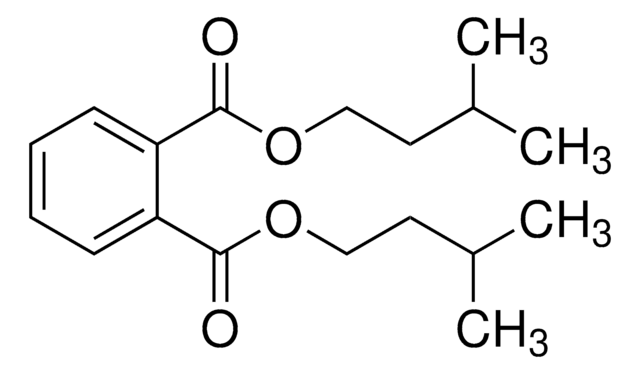80154
Dipentyl phthalate
Selectophore™, ≥99.0%
About This Item
Produits recommandés
Qualité
for ion-selective electrodes
Niveau de qualité
Gamme de produits
Selectophore™
Pureté
≥99.0% (GC)
≥99.0%
Forme
liquid
Indice de réfraction
n20/D 1.490
Densité
1.025 g/mL at 20 °C (lit.)
Chaîne SMILES
CCCCCOC(=O)c1ccccc1C(=O)OCCCCC
InChI
1S/C18H26O4/c1-3-5-9-13-21-17(19)15-11-7-8-12-16(15)18(20)22-14-10-6-4-2/h7-8,11-12H,3-6,9-10,13-14H2,1-2H3
Clé InChI
IPKKHRVROFYTEK-UHFFFAOYSA-N
Vous recherchez des produits similaires ? Visite Guide de comparaison des produits
Catégories apparentées
Description générale
Application
- Biologically relevant reductions in fetal testosterone and Insl3 induced by in utero exposure to high levels of di-isononyl phthalate (DINP) in male rats: Dipentyl phthalate′s structural similarities to DINP underpin studies on phthalate exposure′s impacts on male reproductive health, providing insights into potential risks and mechanisms of toxicity in developmental stages (Earl Gray L Jr, 2023).
- Exposure to dipentyl phthalate in utero disrupts the adrenal cortex function of adult male rats by inhibiting SIRT1/PGC-1α and inducing AMPK phosphorylation: This study uses dipentyl phthalate to examine the adverse effects of phthalate exposure on adrenal gland function, contributing to a deeper understanding of metabolic disruptions (Chen et al., 2023).
- Determination of 15 phthalic acid esters based on GC-MS/MS coupled with modified QuEChERS in edible oils: This research demonstrates the utility of dipentyl phthalate in method development for detecting phthalates in food matrices, enhancing food safety assessments (Wang et al., 2022).
- Development of a putative adverse outcome pathway network for male rat reproductive tract abnormalities with specific considerations for the androgen sensitive window of development: Dipentyl phthalate is investigated for its role in developmental toxicity, aiding in the construction of models predicting reproductive health effects from chemical exposures (Palermo et al., 2021).
Autres remarques
Informations légales
Mention d'avertissement
Danger
Mentions de danger
Conseils de prudence
Classification des risques
Aquatic Acute 1 - Repr. 1B
Code de la classe de stockage
6.1C - Combustible acute toxic Cat.3 / toxic compounds or compounds which causing chronic effects
Classe de danger pour l'eau (WGK)
WGK 3
Point d'éclair (°F)
244.4 °F - closed cup
Point d'éclair (°C)
118 °C - closed cup
Équipement de protection individuelle
Eyeshields, Gloves, type ABEK (EN14387) respirator filter
Choose from one of the most recent versions:
Déjà en possession de ce produit ?
Retrouvez la documentation relative aux produits que vous avez récemment achetés dans la Bibliothèque de documents.
Les clients ont également consulté
Notre équipe de scientifiques dispose d'une expérience dans tous les secteurs de la recherche, notamment en sciences de la vie, science des matériaux, synthèse chimique, chromatographie, analyse et dans de nombreux autres domaines..
Contacter notre Service technique














